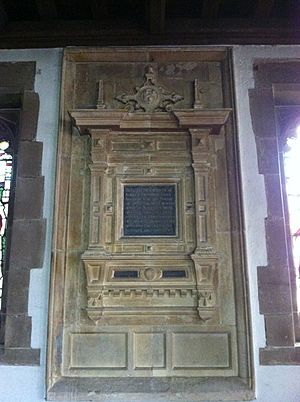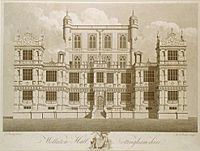Robert Smythson facts for kids
Quick facts for kids
Robert Smythson
|
|
|---|---|

Memorial to Robert Smythson in St. Leonard's Church, Wollaton
|
|
| Born | 1534 or 1535 probably London
|
| Died | 15 October 1614 Wollaton, Nottinghamshire
|
| Nationality | English |
| Occupation | Architect |
| Buildings | Hardwick Hall Wollaton Hall |


Robert Smythson (born around 1535 – died October 15, 1614) was a famous English architect. He designed many important houses during the time of Elizabethan England. Not much is known about his early life. We first hear about him in 1556. At that time, he was a stonemason working on a house called Longleat.
He later designed other well-known buildings. These include Hardwick Hall, Wollaton Hall, and Burton Agnes Hall. Some other old houses, like Gawthorpe Hall and Chastleton House, are also thought to be his work because they look similar to his style.
Becoming an Architect
In Britain during Smythson's time, the job of an architect was quite new. Robert Smythson first trained as a stonemason. A stonemason is a skilled worker who cuts and shapes stone for buildings. By the 1560s, he was traveling around England. He led his own team of masons.
In 1568, he moved from London to Wiltshire. He started working on the new house at Longleat. He worked there for nearly 18 years. He personally carved many of the outside details. People believe he had a big impact on the overall design of the building.
In 1580, he moved to his next big project, Wollaton Hall. At Wollaton, he was more like a "surveyor." This was the word for an architect back then. He was in charge of the whole building process, not just the stone carving.
Smythson's Unique Style
Smythson's building style was a mix of different ideas. You can see influences from the Renaissance period, especially from an Italian architect named Sebastiano Serlio. He also used ideas from Flemish and English Gothic styles.
He was very clever in how he put these ideas together. His buildings were innovative and had classical details. For example, Hardwick Hall is famous for using a lot of glass in its design.
His Legacy
Robert Smythson died at Wollaton in 1614. He is buried in the local church there. His memorial stone says he was an "Architecter (sic) and Surveyor" for Wollaton Hall and other important houses.
His son, John Smythson, also became an architect. John worked on places like Bolsover Castle. Robert's grandson, Huntingdon Smithson, also followed in the family's footsteps as an architect.
Images for kids





